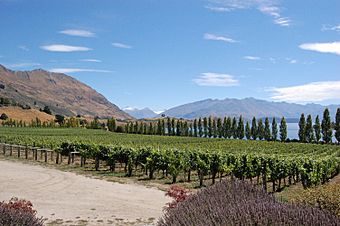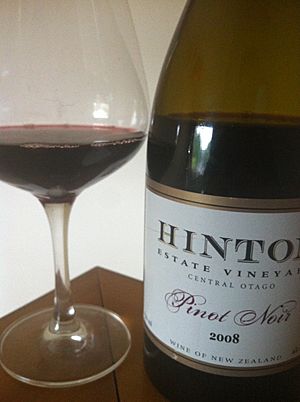Central Otago wine region facts for kids
| Wine region | |

Rippon vineyard in Wanaka, Central Otago
|
|
| Type | Geographical Indication |
|---|---|
| Year established | 2018 |
| Country | New Zealand |
| Sub-regions | Bannockburn, Bendigo, Wanaka, Gibbston Valley, Cromwell, Alexandra |
| Size of planted vineyards | 1,904 hectares (4,700 acres) (2018) |
| Grapes produced | Pinot Noir, Chardonnay, Riesling, Pinot Gris |
| No. of wineries | 136 |
The Central Otago wine region is a special area in New Zealand where grapes are grown to make wine. It's located on the South Island and is actually the southernmost place in the world where wine is made for sale! Central Otago is most famous for its Pinot Noir wine. Many other white wine types are also popular here.
Contents
Discovering Central Otago's Wine History
People from Europe first settled in this region during the Central Otago Gold Rush in the 1860s. A French gold miner named Jean Desire Feraud started planting vines. He even began making wine to sell. His wines won awards in Australian competitions!
Later in the 1800s, the New Zealand government looked into the country's wine-growing potential. While early tests showed Central Otago was great for grapes, the wine business didn't last for long.
In the 1950s, people started trying to grow grapes again. This continued through the 1970s. Both private individuals and the New Zealand Department of Agriculture planted small test vineyards. By 1980, they had enough experience. They felt confident to start growing grapes for sale again.
The number of vineyards grew slowly until the mid-1990s. Then, the wine industry really took off! In 1996, Central Otago had only 11 wineries. This was a tiny part of New Zealand's total. By 2004, there were 75 wineries in the region. The area planted with vines also grew a lot. It went from 92 hectares (about 227 acres) to 1,062 hectares (about 2,624 acres).
Understanding Central Otago's Climate and Soil
Central Otago's vineyards are about 300 metres (980 ft) above sea level. High mountains, up to 3,700 metres (12,100 ft) tall, protect them. These mountains block New Zealand's usual maritime climate (which means it's usually mild and wet).
Because of the mountains, Central Otago has a unique continental climate. This means it has big differences in temperature. Days can be very hot, and nights can be very cold. Summers are hot and dry. Autumns are short, cool, and sunny. Winters are cold with lots of snow. Frosts are common from March to November.
The grape harvest in Central Otago happens much later than in other parts of New Zealand. In warmer northern vineyards, grapes are picked in late February or early March. But in Central Otago, the harvest starts in mid to late April. That's a difference of six to seven weeks!
The soil here is also special. It has lots of rough pieces of mica and other metamorphic schists. This soil drains water very easily. Most vineyards are on hillsides. Because of this, farmers usually need to use irrigation (adding water) to help the grapes grow.
Exploring Central Otago's Famous Wines
Pinot noir is the most important grape in Central Otago. About 70% of all the grapevines planted here are Pinot Noir. This grape makes a famous red wine.
The other 30% of wine production comes from other grapes. These include Chardonnay, Sauvignon blanc, Riesling, Pinot gris, and Gewürztraminer.
Central Otago also makes Sparkling wine. This bubbly wine is made in the traditional way. It uses Pinot Noir and Chardonnay grapes.
Discovering Central Otago's Sub-regions
The Central Otago wine region is divided into several smaller areas. Each of these "sub-regions" has its own climate and special features.
- Bannockburn is near the Kawarau River. Gold miners used to call it "the Heart of the Desert" because it's very warm. Grapes ripen early here in sandy soils. The vineyards are between 220 to 370 metres (720 to 1,210 ft) high.
- Bendigo is east of the Clutha River and Lake Dunstan. Grapes are planted at different heights here. This area is warm and has dry soils. The Bendigo sub-region also includes vineyards at Tarras and Maori Point.
- Gibbston is a narrow valley surrounded by mountains. It's the coolest and highest sub-region. Vineyards are between 320 and 420 metres (1,050 and 1,380 ft) high. About 250 hectares of vines grow on the southern bank of the Kawarau River.
- Wanaka is the smallest sub-region. Its vineyards are near Lake Wānaka and the town of Luggate. They are between 290 to 320 metres (950 to 1,050 ft) above sea level. The climate is similar to Gibbston, but a little warmer.
- The Alexandra Basin is surrounded by the Clutha River and Manuherikia River. It often has New Zealand's hottest summer temperatures. The landscape has many Schist rock formations. Even with high temperatures, the nights are much cooler.
- The Cromwell Basin has the most vineyards. It's located between the Kawarau River, Lake Dunstan, and the Pisa mountains. This warm area has dry, high terraces and gently sloping fans.



